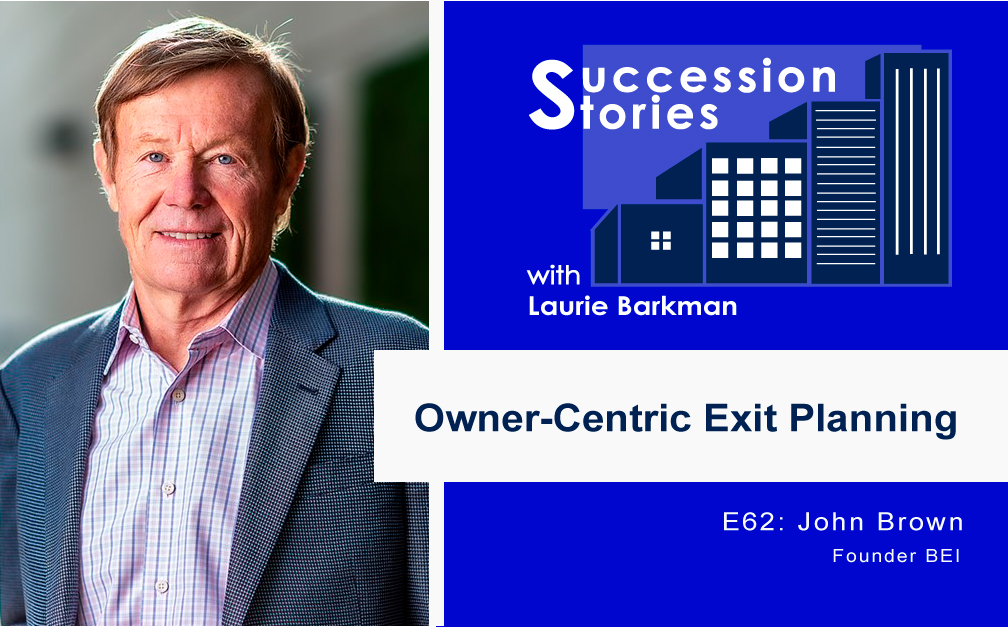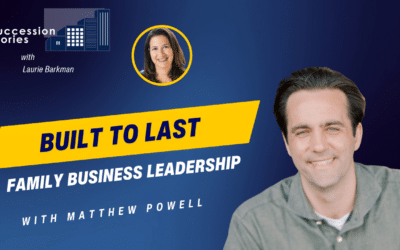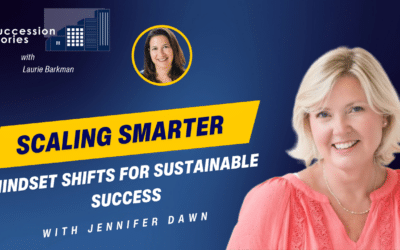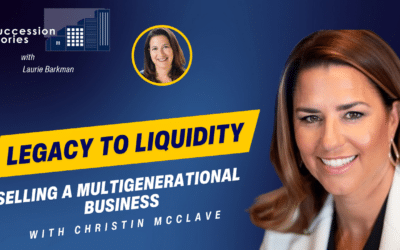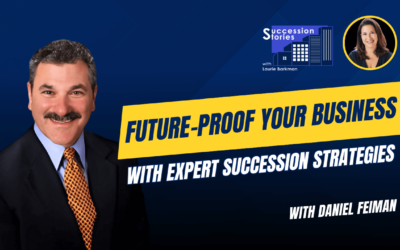Listen in as Laurie Barkman talks with John Brown about taking an owner-centric approach to exit planning to achieve your financial goals and be rewarded with the lifestyle you desire. Only 20% of business owners have a formalized plan to transition ownership, but 100% will exit their company one day. John Brown, best selling exit planning author, started BEI in 1996 for the purpose of helping owners benefit from their lives’ work by supporting business advisors who share the same vision.
Listen to learn more about:
- Working with a financial advisor for future planning
- What builds business value
- Why exit planning is business planning
- How an owner-centric approach to exit planning can help you achieve your transition goals
- Assessing obstacles to the exit scenario you’ve envisioned
- How to prevent transition plans from falling through
Show Links:
BEI website: https://www.exitplanning.com/
Podcast website: SuccessionStories.com
Transcript:
Laurie Barkman:
John Brown, welcome to Succession Stories. I am really excited that you had reached out to talk with me because I’m so interested in talking to you. You are the founder of BEI, which is a very well established firm that helps business owners plan for their future and for their business transition. I know we have a lot of business owners listening that might not know about what you and I specifically are talking about. So I think it’s a great educational opportunity for how business owners can think about the sense of transition and their company and really building value, so welcome.
John Brown:
Thank you, Laurie. It’s great to be here.
Laurie Barkman:
I want to start us off with something that I saw on your website, which is so obvious that it’s almost funny, but I think it’s good to state the obvious, which is, 100% of business owners will stop being owners at some point. That’s a very obvious thing to recognize. But the important thing for this conversation is that only 20% of business owners have a written plan to transition ownership. So for today, I think it’s a great way to talk about what is exit and succession planning, and why is it important for business owners? Why don’t we start with you and your background, and if you can share how you got involved with exit planning and why you started your company BEI?
John Brown:
Sure. Well, a long time ago, I was a young person, and my parents owned a business, so really from almost from age four, I’ve been involved in businesses in some capacity. My parents sold their business when I was in law school, to their key employee. Like all people from Michigan, they retired to Florida. About six months later, they came back to Michigan because the business was failing and it did fail, and the business was liquidated. So that was my first exposure, I guess to what a lot of business owners do that I don’t want any other business owner to have to go through which is the liquidation of their business through a failure to appreciate what’s required if you want to exit your business, on your terms.
After law school, I moved back to Colorado where I’d gone to undergrad, co-founded a law firm after a few years, and eventually, actually fairly quickly, the firm separated into more or less two areas. One was a merger and acquisition practice, much like what you do and my partner was in charge of that, and I was in charge of our planning side, that’s estate planning, and what we called back then business planning, which was pretty basic. That developed over time, as I realized that owners didn’t really know what to do as they prepared, whether it’s for a third party sale, or giving it to their children, or transferring it to their key employees. They just had no idea of what to do. So as a result, they eventually did something and they wound up like my parents did. That gave me the idea of starting up planning based planning, I called it exit planning. There was not a term exit planning used way back then and we really developed that.
After about 10 years, I wrote a book called How to Run Your Business So You Can Leave It in Style, and it was aimed at business owners. It surprisingly sold a lot of copies, I think we ended up publishing about a quarter million copies and so that really put us on the map. From there, I realized I was more interested in helping owners come up with a plan, develop a plan, execute a plan to leave their businesses, but I wanted to do it through other advisors because I was pretty limited in how many owners we could represent. So I really developed BEI, Business Enterprise Institute, to train advisors all around North America and we’ve trained 1000s of advisors in what exit planning is and how they can use that to help their owners leave their business. Part of that then we also have… BEI is essentially a membership-based organization. We have 1500 advisors around mostly in this country that we support with marketing tools, planning tools, software tools to develop and implement an exit plan. That continues to be developed constantly as we still learn more about the whole planning process. So that’s my story, so here I am.
Laurie Barkman:
That’s a great story. It’s always helpful when your sense of the problem is firsthand experience and so for you it’s with your family business, your parents’ experience, and so you’ve got this mission to help make sure that others don’t have the same fate. Let’s talk about this phrase, exit planning. There are other phrases that we use to talk about it because exit sounds negative, “Oh, I’m exiting, I’m leaving,” and I think that there’s some data out there that says when people have something they’re going to, they feel more positive about it. There are other phrases also. But of course, as you said, the foundation of BEI is exit planning but if an owner is listening to this episode, and thinking, “Oh, exit planning, I’m not ready to exit my business. I have another 10-15 years, I’d like to work in my company.” What are some of the considerations around that? What does it really mean to be planning for a business transition?
John Brown:
Well, that’s an interesting question. Our surveys, we survey business owners every other year, our last survey, we asked the question, “When are you planning to leave your business?” We didn’t say exit, so it’s really leaving your business. For almost all advisors, that would mean while they’re going to sell their business, they’re going to give it to their kids, they’re going to exit the business. But in phrasing the question that way, we found that 80% of owners wanted to leave the business within 10 years and that is very consistent with our surveys going back many years, it’s always been about 80% want to leave the business and 10 years, but 25% of owners want to leave their business, but not sell it, to keep ownership. They just don’t want to have to go to work every day and that’s something that is not obvious to most advisors, and owners should realize, if that’s something you want to do, advisors are trained to help you do that. The BEI is premised on the fact that it’s owner centric; we train advisors, and we provide tools and information with the idea that what is it that the owner wants to do? It’s called owner centric planning. So if the owner says, “You know, I want to keep this business for 10 years, and then I want to just liquidat it,” we talk to her about that, to make sure they thought through the pros and cons. But if that’s what they want to do, that’s what we do.
Laurie Barkman:
Yeah, and as someone who, for me, speaking with my own experience with my clients, that’s absolutely the philosophy that I take, trying to understand what’s important to them, and try to get from them what their future vision is. So if like, as you say, they want to shift to Chairman or Chairperson and just not be in the day to day role, we plan for that, or if they want to transition their company to the next generation of managers so the next generation of family, we plan for that, but if we want to sell, and maybe they have a mountain climber mentality, and they want to move on to the next, maybe start another business or buy a business support that too so I think that’s really critical. We can’t assume the answer is always to sell the company. But that said, there are a lot of, in the in the press and the media, we hear about this phrase, the silver tsunami, and this wave of retirements that are coming from baby boomers who own their own company, looking to retire and maybe sell their business or perhaps as you said earlier, they might liquidate if they don’t find a buyer. So what will happen if there’s no family to take it? And what are the implications for the economy? What are your thoughts around the silver tsunami?
John Brown:
Well, the silver tsunami never occurred. People have been talking about that for at least 20 years, “It’s just around the corner. It’s happening right now.” Well, it hasn’t happened. Clearly, Baby Boomers are going to start dying off at a faster pace so it will increase from that perspective, but for a lot of owners if they can develop the business the way they want to develop, I don’t think they’re going to necessarily leave all the time. Like I said 25% of owners would like to stay indefinitely. Most owners, once they understand what their lifestyle they want to leave after they’ve transferred ownership, is not going to be that much different, they don’t want it to be much different than the lifestyle they enjoyed today. Once they think through that, and how much money they’re going to need by working with people like you, Laurie, they realize they can’t leave, they can’t exit their business because they won’t be able to maintain their lifestyle.
So the foundation of a lot of exit planning we do is to first understand clearly what the lifestyle wants and needs of the owner and family are. Then are the resources available now through the value of the business investments etc. available to meet that lifestyle, want or need, should the owner sell the business? Usually there’s a gap so in exit planning for the owners listening in, I would really emphasize, you need to work with a team of advisors. Don’t work with just your CPA or just your lawyer or even just your financial planner. It’s going to take a number of different advisors eventually, to develop and implement a plan to allow you to leave the business, again, when you want for the money you need, to the people you choose, and, maybe to achieve other goals and aspirations. We have to understand that and then we will work with you. Usually exit planning starts with working with a financial planner to determine what you have, as a business owner, to determine how much money you need. I’m sure Laura, you do something more sophisticated than a financial needs analysis but that can be a starting point. What do you need to have, and can you transfer your business now and achieve that or not? If not, we need to plan.
Laurie Barkman:
You mentioned a gap so let’s talk about the gap. Because I think the gap is the big ‘why’ as to why business transition planning should not be last minute if you have this, as you said, this financial plan, and you have this vision of how you want to live your life. For many people, the definition of wealth means to be able to do what they want, whenever they want. This freedom to control your time, especially after what we’ve gone through the last year plus with COVID is that a lot of people are really seeing that time is the biggest resource we have. So if we say, “Okay, I need this much to live this lifestyle,” and then we get an estimate of value on our company or perhaps a formal certified valuation either way, we get an understanding of what the business might be worth to a third party, not just what we think or not what we heard at the country club as somebody else’s multiple but our actual multiple and so what’s our business worth today and so perhaps there’s a gap. What I think about is this gap, and how do we close the gap? And John, I suspect that that’s a big reason why you advocate for this being a process that takes some time to really get through, is that right?
John Brown:
Right. You’re exactly right. It starts with understanding what the gap is, maybe, it’s $20 million, maybe it’s nothing but you really can’t do exit planning as a professional without knowing with accuracy what that gap is. Usually the gap tends to be significantly greater than the owner’s perception, so that’s why we work with professionals, a financial planner, maybe a business valuation person to give us a calculation of value and other professional stuff first to understand what the gap is and then how do we close it. Part of that though, when you say, “How do we close it,” we have to understand that the owner also has a goal of who he wants or she wants to transfer the business to. For our members that we support, about two thirds of the exit paths are not third party sales. It’s a common belief out there that most exits are third party sales. Maybe most exits are third party sales. It’s because they haven’t done any planning to provide for a path they would rather go down. So if I could sell my business, meet my financial and other goals and transfer it to my key employees or to my children or to an ESOP, most owners would want to do that, and again, a lot of what we do in BEI is to help owners understand they can do that. They say, “Oh, I can’t do them when I have to sell to a third party.” We might want to talk about this, Laurie, because I think you talk about building value, that’s a major part of your practice. You still have to have the same elements in the business that build value, whether it’s to a third party or to a management team. You have to have good management, you have to have good operating systems, etc. regardless of the exit path, and owners just don’t seem to understand that sometimes. So it’s an information process for owners, and my parents didn’t understand that, and the result was not pretty.
Laurie Barkman:
It’s about options, really.
John Brown:
Really.
Laurie Barkman:
Creating the best option for you so that you can choose. You’re not boxed into something. How much time, on average, would you say that it takes to go from, “Hey, I’m thinking of selling,” or “I’m thinking of transitioning,” to signing the paperwork on average? Is it about 10 years?
John Brown:
It depends so much. You could have a business owner, she’s developed a great business, it has a couple million dollars of pre-tax earnings a year, she can probably leave today, if she wants, she decides she wants to leave. Or you could have a business owner who has…years ago, I had an owner come to me and they said, “John, I want your firm to sell my business.” I said, “Okay, now tell me a little bit about it.” He said, “Well, it’s worth $10 million dollars.” I said, “That’s interesting. Tell me how you got to that.” He said, “Well, I have a million dollars of revenue and I heard that you can get 10 times revenue when you sell your business.” Now, that’s a pretty extreme example but if we don’t have a good perception of where we’re starting from, it’s impossible to say how long it’s going to take. Then what he decided to do, planning as a business owner and implementing the plan, with some discipline makes a huge difference. So the timing is based on the facts and circumstances of the owner and the willingness to engage in planning and implement a plan.
Laurie Barkman:
Absolutely. In your experience, what are some examples of where a transition plan or an exit plan just did not get over the goal line, it just fell through?
John Brown:
When we actually start to create a plan, in our world, that means there’s going to be a written plan and you’re going to start with the goals and aspirations, the resources, and understanding what the gap is. Then you may have to develop value through incentivizing the management team of a variety of other tools and value drivers. Usually what happens at that point, and then from there, you’re going to move down maybe an ownership transition path by starting to sell to employees, or gifting to children, etc. Usually, what causes the plan to fail, is that the business doesn’t grow in value at the pace the owner and the advisory team thought it was gonna grow.
What causes that? It can be a variety of different factors: the management team we selected isn’t up to snuff or not properly motivated, the owner doesn’t stick to the knitting and they start to not pay enough attention to the business, the advisory team chosen is not really top notch. I’m using my estate planning attorney, I’m using my bookkeeper slash accountant to do the planning work, while they probably don’t have the experience, or the knowledge to really help the owner.
Again, part of what I think owners should do is to work with a trusted advisor that they have if they have one who is at the top of their game and if their advisor isn’t that, to talk to other owners, to see who really is a leading advisor in their community, and then talk to that person. They will know the other top notch advisors in their community. So I really think it’s important to work with capable experienced advisors who have worked with successful business owners and helped them do something that grows value or allows them to exit. That’s really important. Without that, you can’t just can’t do it. It would be like the Denver Broncos, usually they have a pretty lousy quarterback and so we don’t go anywhere and we have a Peyton Manning, suddenly we can win Super Bowls. It’s the same concept. You need a trained advisor, and I would suggest that person be trained in exit planning.
Laurie Barkman:
Absolutely. It makes me think, entrepreneurs don’t build their businesses alone so why would they sell their business on their own? Or why would they try to transition on their own? Having a team, a collaborative team, I would also add the word collaborative. I think that’s important, as you mentioned, between people who have different fields of expertise, but that work together on behalf of the owner. I think that’s all really relevant. Is there an ideal time to start exit planning? If you are, let’s say maybe it’s age based, if someone’s saying, “Well, I want to retire when I’m 65.” Okay, so if we work backwards, that’s one way to look at it. But the other thing I would love your thoughts on is, isn’t business succession planning really just financial, getting your finances in order and making sure your business is healthy and helping it ensure sustainability to the next generation? So doesn’t it just make good economic sense to do all the things that we’re talking about, in the big picture to grow value and your company? Perhaps it’s a phased approach, where there’s this growth phase and really thinking about what makes my business transferable. Perhaps there’s trade-offs between some decisions we’ll make, “Well, do I hire that person, which could hurt my profitability this year, but would really help my profitability in the future?” Maybe it’s really about short term and long term thinking.
John Brown:
Yeah, that’s a good question, Laurie, because owners are, if they’re thinking long term, they’re also torn by the fact that there’s a lot of short term things that they need to do. So the way we begin a planning engagement, or thinking about a planning engagement with a business owner, regardless of their age, is usually we use an assessment to see what is important to the owner, what are her concerns right now? Because we often need to address those concerns before they’re going to really be serious about longer term planning, and such is the tool that we have. That’s the first thing.
We didn’t always have that so our members, we’d often talk to an owner, and they’d say, “Oh, yeah, I really need to do some exit planning, and nothing happens.” I think you probably have been there, like all the other advisors so it’s important to catch their interests, “So you’re telling me that you’re really concerned about what happens as a sole owner, if you suddenly pass away,” or, “You know that your one key employee has been approached by competitors offering them a higher salary? Let’s address those issues. And once we’re done with that, that’s actually planning, we’ll move on to the next.”
So for owners listening in, I don’t want to have you have the perception that you have to do all of this big estate exit plan, and it’s gonna take years and years. No, just take nibbles. Start to solve some issues. You’re going to do that in the context, however, really of exit planning, that you may not even be aware that you’re exit planning but if you motivate and keep a key employee, in my example, well, maybe you design that incentive plan to motivate the key employee to grow the value at the pace necessary to eventually allow the owner to exit on her terms. So that’s exit planning. You sneak that in sometimes. But owners appreciate that so it’s really hard to say how long it should take. It depends on the business of the owner. But the biggest barrier to exit planning or planning for the future is the owner not doing anything, and we understand they’re busy, but we can help them become less busy.
Laurie Barkman:
Yeah, absolutely. There’s a gentleman I’ve been speaking with for a few months, and he hit his busy season, their seasonal business and he said, “I definitely want to work with you. I just don’t have the time right now. Because I’m short staffed. I’m trying to hire these positions, come back to me in a month,” and what you’re saying is really resonating. That’s the situation that he’s in. He’s trapped, he’s trying to get out of it. He wants to do exit planning, but the here and now is preventing him from making that happen.
John Brown:
Yeah, and the problem is when you go back in a month, he’s gonna say what? “I’m too busy right now,” and so that’s why I’m suggesting, “Okay, why are you too busy?” “Well, because, you know, my bookkeeper’s lousy and I have to spend too much time myself going through the numbers.” “Okay, we can help you with that.”
Laurie Barkman:
Exactly.
John Brown:
So yeah, that’s why I love doing this. You can tell I’m pretty passionate about this.
Laurie Barkman:
Absolutely. You are. Let’s make this actionable. If a business owner is listening, and they’re thinking, “Okay, you know, I fall into that 10 year category where maybe I want to work in my business another 10 years. What’s the first step?” Obviously, I’d love for them to reach out to somebody like me, so I’m not necessarily advocating “Okay, anyone listening, call Laurie Barkman.” Of course, I’d love them to. But if we are talking just generally, is step one an assessment to just generally understand where they are today, and then have the dialogue?
John Brown:
I think that would be part of step one. Not only for them to understand where they’re at, our assessment at least doesn’t do that. It just identifies issues and concerns we can help them with but that is one part of it. I think, and it’s really important for engagement purposes. The first step is to work, Laurie, with a good financial planner. That is the first step. Almost half of our members are financial planners and there’s a reason for that. Because you can’t do exit planning, unless we know the financial condition of the owner, and what his or her goals are. That’s part of what financial planners do. I don’t want to limit it to that but part of what I think you do is to say, “What are your financial goals and aspirations? Where are you today?” A financial planner would say, “Well, I can help you achieve your financial goals through investment advice and things like that.” A financial planner/exit planner has a much broader field of knowledge and a much broader capability to help the owner actually do exit planning but it has to start with, in my parlance, a financial needs analysis. I don’t even know if that’s quite the correct term a financial planner would use but we need to know what they need and they need to know what they need.
Laurie Barkman:
Absolutely, and I collaborate with not only wealth managers, but also M&A attorneys, and others who support business owners in this process and I’m happy to recommend people in my network for that and I know you do too, so that’s a great place to start. I love that. So John, I love to ask all of my guests if they have a favorite quote to share for entrepreneurship or leadership. Do you have one?
John Brown:
You asked me that earlier and I do. I have a favorite quote by this source of a lot of wisdom and his name is Peter Drucker and he’s deceased now. But he was maybe the first really internationally famous management consultant type person, a brilliant person. He taught at college, Carleton College, I think, in California or Claremont college, or other almost until he was 90 years old. He wrote a dozen or more books on how to run a business, the role of management in developing and growing a business. One of his quotes is that entrepreneurial businesses, as opposed to maybe an IBM, need to hire top management before they can afford them. I read that years ago, and I thought, “This is the one quote that I just don’t agree with,” but he’s absolutely correct. If a business owner doesn’t have top management, and you want to grow your business, you want to develop a plan to someday leave your business, you’re not going to do it without having a top flight management team that creates value in your company. It can’t be the owner creating all of the value or it won’t be transferable.
Laurie Barkman:
Absolutely. Peter Drucker, I think, is the number one quoted person on this show. I agree with you. He is a wealth of wisdom. You’ve shared so many great things today, John, if people want to follow up and learn more about you or BEI, what’s a great way for them to do that?
John Brown:
Well, the easiest thing to do would be to go to exitplanning.com. That’s one of our websites and that is the website advisors go to but also owners can use that website to get additional information on exit planning. Maybe to find advisors, we have a list of trained advisors on the website, and so on. So that would be the first place to go.
Laurie Barkman:
Great. Thank you, John. Thank you so much for coming on Succession Stories and talking about exit planning and succession planning with us. I really appreciate it.
John Brown:
Thank you very much, Laurie, it was a joy.

